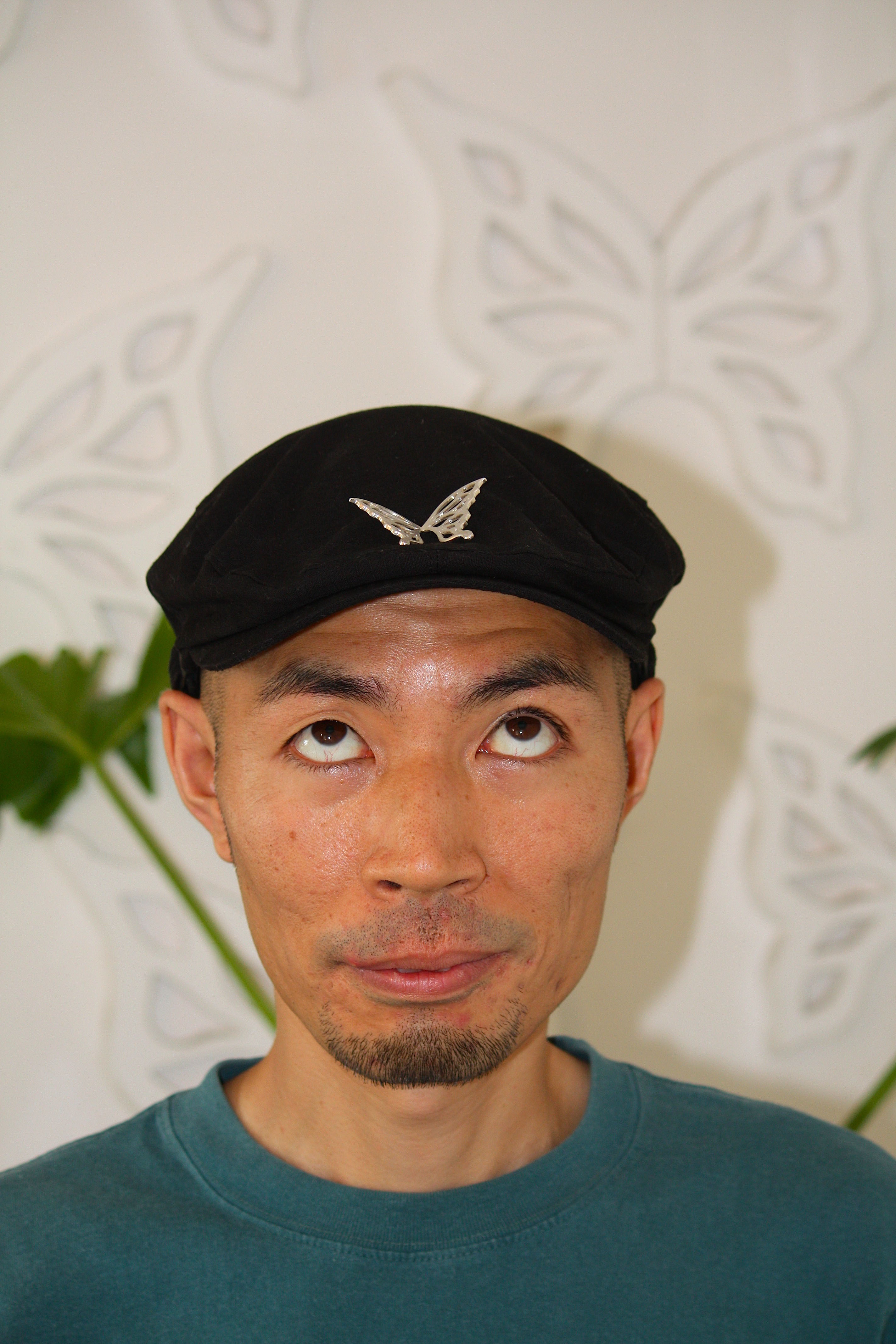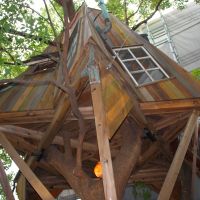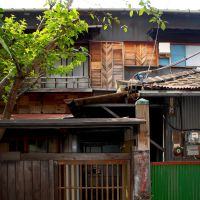Exiting the Nanboku Line at Shirokanedai Station in west-central Tokyo, my sandaled feet immediately start to sizzle. So instead of walking to Meguro's Institute of Nature Study as planned, I bolt down the first shaded slope I find.
A chic aluminum-and-glass building with a cool and cavernous interior catches my eye. Not sure whether design shop Haaz is open, I lean into the gloom and call out. No answer. I do a Goldilocks and enter anyway, admiring handmade pottery, glassware and wooden furniture in Papa Bear and Mama Bear sizes.
In the rear of the store, svelte chairs hang like art on a wall that plunges into a basement area, where I see more table settings displayed. From somewhere comes the sound of sawing. I call out once more. This time, a man emerges from a hidden room below, and we startle one another.
Makoto Hashimoto, at 59, vivacious in geta and work gloves, beckons me down. "I didn't hear you because I'm assembling test chairs right now," he explains as I descend to meet him, "and the lights are off because of restrictions on electricity use since the March 11 earthquake."
He draws back a curtain concealing his workshop, chockablock with chisels and saws. Baby Bear chairs, actually one-fifth-size models of Hashimoto's award-winning, featherweight birch-plywood furniture, line shelves. "This is from my Aircore series," Hashimoto says, bobbing one of his full-sized chairs effortlessly on a single finger.
Haaz — from the "ha" of Hashimoto, and "A to Z" — also sells work by Hashimoto's wife and daughter, who are both designers. I admire their glassware, clear and tinted slabs fused like pools of water.
"We're a san-chan shōbai," Hashimoto proudly proclaims, referring to the 1960s expression describing three family members — obāchan, ojīchan and okāchan (grandma, granddad and [their] daughter) — who were often left behind in small towns or villages when others in the family left for jobs in the cities.
I mull over this concept — designers as those left protecting the home front — as I bid Hashimoto farewell.
A bit down the slope, I spy a home front worth protecting. An aging tile roof, wooden amado (rain shutters) and sliding entrance gate tell me the house is quite old. Ryoko Kasamatsu, 67, and his wife Takako, 65, out tending their robust goya (bitter cucumber) vine, confirm this. "It's at least a century old," Takako allows, "or so people in the neighborhood told us when we moved here."
The Kasamatsus are tenants, I learn, but in spirit they obviously "own" their abode. "New houses are so boring," Ryoko says, "and we didn't want to renovate this one at all, but just last year we had it quake-proofed — and in March, it proved solid."
Takako shows me a section of the outside woodwork which Ryoko himself repaired in the original chevron pattern. "He used wood from old pottery boxes," Takako explains, pointing out the signatures of craftsmen still visible.
Invited inside for iced wheat tea, I learn that the Kasamatsus are antique dealers with attitude. Apparently, business is suffering right now. "Young people have no understanding of what antiques are," Ryoko says. "Japan is really in the danger zone, not financially, but culturally, and if schools don't begin to pay attention, we'll lose the skills and workmanship we're known for."
I gently nudge the conversation back to the house. "If everyone around here had fixed up their old homes," Ryoko says, still agitated, "it would look like Kyoto." Takako nods. "Old houses can get cold and dusty, and we extracted a big mummified bird from our rafters, but we want to stay here until we die."
With that, we part, and I descend into a lowland residential maze of dead-end alleys before climbing out to find the backside of a copper-clad behemoth, Philippe Starck's 1989 Unhex Nani Nani building. Supposedly, the "Nani Nani" part of its name was added because its builders kept saying "Nani? Nani?!" ("What? What?!") when consulting the architectural plans.
Now, though, perusing the building's tenants, I find a "nani?!" factor of my own. Up on the top, fifth floor, I meet Yosuke Shiraishi, 34-year-old owner and creator of the Planetarium Bar. His universe features a crescent of red velvet sofas around a projection dome. But after he closes a complex system of curtains, the bar becomes a black hole. When he finally switches on the planetarium ball, the heavens light up, and even without alcohol, I see stars.
Entrance plus two drinks is ¥3,150, while ¥4,200 lets you imbibe to infinity and beyond (for two hours). Though it's still midday, I wish Shiraishi goodnight, and head out into the blazing sun again.
The Japanese characters for Shirokane mean "white gold," which at first glance is indistinguishable from platinum, and this may be the origin of the name of the avenue I walk down. Platinum-dori has a plethora of commercial wedding venues. Though slightly ersatz with its giant white bells, fairy lights and wannabe pomp-and-circumstance architecture, the avenue courts appreciation.
When I stumble upon a potted fig tree loaded with blushing fruit, I naturally mistake Biotop for another nuptial facility. Instead, it's an upscale retail complex with an ironically down-to-earth feel.
Exploring, I brush past Botanical Fuga's lush plants and follow the scent of herbal perfumes bottled by nuns at Florence's Santa Maria Novella church. On the second floor, as I peruse the select clothing in Adam et Rope, I notice outside, on a level with the third floor, a star-shaped house wedged in a tree. Can I go in it? "Sure," says store manager Ayako Sunabe.
Climbing iron steps, I enter a quirky structure with angles and warped perspectives that resembles a set from Robert Wiene's 1920 silent-movie classic, "The Cabinet of Dr. Caligari." It's not your average treehouse, but it has the sway and scale of a childhood fantasy.
Initiated by four guys — Takashi Kumagai (creative director), Hiroshi Kobayashi (green coordinator), Takashi Kobayashi (treehouse creator) and restaurateur Uichi Yamamoto — Biotop has a overarching goal, Sunabe tells me once I de-tree. "One percent of all Biotop profits go to support More Trees" (an organization chaired by Oscar-winning musician/composer Ryuichi Sakamoto that's geared toward protecting and increasing forests worldwide), she says. I like the idea, and how the complex celebrates all branches of life.
From there, trudging up a broiling sidestreet at the edge of a residential area, I find atelier and jewelry shop Chikara. Owner and artisan Chikara Watanabe, 36, is busy polishing the wing on a silver butterfly ring, one of his trademark creations.
I check out his uber-delicate, bio-inspired designs, one-of-a-kind sculpted pendants, and an oversize hibachi in the center of the shop. "In the winter, friends and clients gather here," Watanabe tells me. In summer, his airy studio showroom is graced with plants. "I just rebuilt my building," he says. "It used to shake in a strong wind. If I hadn't done it before the (March 11) earthquake, it would have pancaked." Timing is everything, I think, bidding Chikara farewell and retracing my steps up Platinum-dori.
En route, I meet two Bangladeshi physicians, Shanawez Hassain, 35, and his wife, Tanita Noor, 30, residents in University of Tokyo student housing. Tanita, a fourth-year grad student studying allergens and rheumatology, agrees to show me a shortcut back to the station through the grounds of the University of Tokyo's Institute of Medical Science.
Deafening cicada songs swirl around Japan's foremost life-science research facility, graced by a Gothic-revival structure designed by Yoshikazu Uchida (1885-1972). I note an impressive building in the same vernacular, though it's fenced off from the university grounds. Noor knows little about it, so I seek out the institute's Chief International Adviser, Robert Whittier. "That was also designed by Uchida, in 1938, and is the former Institute of Public Health," he explains.
I recall that antique dealer Ryoko Kasamatsu pointed out the place earlier, suggesting that because the institute was built with donations from the Rockefeller family, the entire area escaped bombing during World War II. "There might be some truth to that speculation," Whittier concedes. "But a B-29 bomber's fuselage crashed right inside the gates."
Though closed for a few years now, the Institute of Public Health is said to be gorgeous inside, with chandeliers and marble floors. Now in the hands of Minato Ward, its future is uncertain — but hopefully, building appreciation will open its doors once more.























With your current subscription plan you can comment on stories. However, before writing your first comment, please create a display name in the Profile section of your subscriber account page.